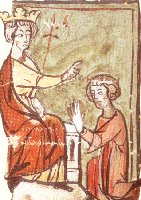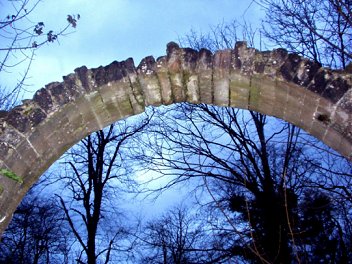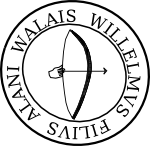|
Capitulation Of Irvine
The Capitulation of Irvine was an early armed conflict of the Wars of Scottish Independence which took place on 7 June 1297. Due to dissension among the Scottish leadership, it resulted in a stand-off. Prelude In May 1297, William Wallace killed William de Heselrig, the English High Sheriff of Lanark. At the time, it was not an isolated incident, although it is unclear whether this was a spontaneous occurrence or co-ordinated with other risings in Scotland. The story that Wallace was seeking revenge for the killing by Heselrig of his wife, Marion Braidfute of Lamington is derived from the poem by Blind Harry, '' The Actes and Deidis of the Illustre and Vallyeant Campioun Schir William Wallace''. Wallace then joined with William the Hardy, Lord of Douglas, and they carried out the raid of Scone. This was one of several rebellions taking place across Scotland, including those of several Scottish nobles and Andrew Moray in the north. Irvine John de Warenne, 6th Earl of Su ... [...More Info...] [...Related Items...] OR: [Wikipedia] [Google] [Baidu] |
Wars Of Scottish Independence
The Wars of Scottish Independence were a series of military campaigns fought between the Kingdom of Scotland and the Kingdom of England in the late 13th and early 14th centuries. The First War (1296–1328) began with the English invasion of Scotland in 1296, and ended with the signing of the Treaty of Edinburgh–Northampton in 1328. The Second War (1332–1357) began with the English-supported invasion by Edward Balliol and the 'Disinherited' in 1332, and ended in 1357 with the signing of the Treaty of Berwick. The wars were part of a great crisis for Scotland and the period became one of the most defining times in its history. At the end of both wars, Scotland retained its status as an independent state. The wars were important for other reasons, such as the emergence of the longbow as a key weapon in medieval warfare. The First War of Independence: 1296–1328 Background King Alexander III of Scotland died in 1286, leaving his three-year-old granddaughter Marga ... [...More Info...] [...Related Items...] OR: [Wikipedia] [Google] [Baidu] |
Henry De Percy, 1st Baron Percy
Henry de Percy, 1st Baron Percy of Alnwick (25 March 1273 – October 1314) was a medieval English magnate. He fought under King Edward I of England in Wales and Scotland and was granted extensive estates in Scotland, which were later retaken by the Scots under King Robert I of Scotland. He added Alnwick to the family estates in England, founding a dynasty of northern warlords. He rebelled against King Edward II over the issue of Piers Gaveston and was imprisoned for a few months. After his release, he declined to fight under Edward II at the Battle of Bannockburn, remaining at Alnwick, where he died a few months later, aged 41. Origins Henry was born at Petworth in Sussex in 1273, seven months after his father's death, saving the family line from extinction, as two older brothers had died in infancy, and all six uncles had died without leaving any legitimate heirs. He was fortunate in having the powerful John de Warenne, 6th Earl of Surrey as his maternal grandfather. He ... [...More Info...] [...Related Items...] OR: [Wikipedia] [Google] [Baidu] |
Military History Of Scotland
Historically, Scotland has a long military tradition that predates the Act of Union with England. Its soldiers form part of the armed forces of the United Kingdom, more usually referred to domestically within Britain as the British Armed Forces. History prior to the Union Royal Scots Navy There are mentions in Medieval records of fleets commanded by Scottish kings including William the LionP. F. Tytler, ''History of Scotland, Volume 2'' (London: Black, 1829), pp. 309–10. and Alexander II. The latter took personal command of a large naval force which sailed from the Firth of Clyde and anchored off the island of Kerrera in 1249, intended to transport his army in a campaign against the Kingdom of the Isles, but he died before the campaign could begin.A. Macquarrie, ''Medieval Scotland: Kinship and Nation'' (Thrupp: Sutton, 2004), , p. 147. Viking naval power was disrupted by conflicts between the Scandinavian kingdoms, but entered a period of resurgence in the thirteenth ce ... [...More Info...] [...Related Items...] OR: [Wikipedia] [Google] [Baidu] |
Capture Of Berwick (1296)
The Sack of Berwick was the first significant battle of the First War of Scottish Independence in 1296. Background Upon the death of Margaret, Maid of Norway, in late September 1290, there arose a number of claimants to the throne of Scotland. The Guardians of Scotland were the ''de facto'' heads of state until a king was chosen. The late king, Alexander III, had been married to Margaret of England, sister to Edward I, and he was asked to conduct the court proceedings in the dispute, though not to arbitrate; the decision was to be made by a jury of 104 "auditors". John Balliol, a descendant of King David I, was chosen and was inaugurated at Scone, on St. Andrew's Day, 30 November 1292. Edward I treated Scotland as a feudal vassal state, claiming contributions toward the cost of the defence of England. When he demanded military support for his war against France, the Scots responded by forming an alliance with the French, and launched an unsuccessful attack on Carlisle. Batt ... [...More Info...] [...Related Items...] OR: [Wikipedia] [Google] [Baidu] |
Seagate Castle
Seagate Castle is a castle in North Ayrshire, in the town of Irvine, close to the River Irvine, Scotland. The castle was formerly a stronghold, a town house, and later a dower house of the Montgomery Clan. The castle overlooks the oldest street in Irvine, which was once the main route between the town and the old harbour at Seagatefoot, which by 1606, was useless and abandoned due to silting. The remains of the castle are protected as a scheduled ancient monument. History The Royal Burgh The first record of Irvine is in 1163, and the harbour at that time was near the sea-gait or Seagate, the castle being first built to protect it. Progressive silting was recorded by several early authors, who recorded that wind blowing the sand hindered the movement of ships, sometimes stranding them for several months. Irvine was created a Royal Burgh by King Robert II in 1372 and this castle is the last of the town's old civil and ecclesiastical buildings to survive, the Carmelite friary, t ... [...More Info...] [...Related Items...] OR: [Wikipedia] [Google] [Baidu] |
Robert Wishart
Robert Wishart was Bishop of Glasgow during the Wars of Scottish Independence and a leading supporter of Sir William Wallace and King Robert Bruce. For Wishart and many of his fellow churchmen, the freedom of Scotland and the freedom of the Scottish church were one and the same thing. His support for the national cause was to be of crucial importance at some critical times. Bishop and guardian Robert Wishart belongs to the Wisharts, or Wisehearts, oPittarrow Kincardineshire, a family of Norman-French origin. He was either the cousin or nephew of William Wishart, Bishop of St. Andrews, a former Chancellor of Scotland. Wishart's first recorded office in the church was as archdeacon of St. Andrews. He was appointed Bishop of Glasgow in 1273. As well as a churchman he became a prominent political figure during the reign of Alexander III. After the death of Alexander in 1286 Wishart was one of a panel of six Guardians, appointed to take charge of national affairs for th ... [...More Info...] [...Related Items...] OR: [Wikipedia] [Google] [Baidu] |
Robert The Bruce
Robert I (11 July 1274 – 7 June 1329), popularly known as Robert the Bruce (Scottish Gaelic: ''Raibeart an Bruis''), was King of Scots from 1306 to his death in 1329. One of the most renowned warriors of his generation, Robert eventually led Kingdom of Scotland, Scotland during the First War of Scottish Independence against Kingdom of England, England. He fought successfully during his reign to regain Scotland's place as an independent kingdom and is now revered in Scotland as a folk hero, national hero. Robert was a fourth great-grandson of David I of Scotland, King David I, and his grandfather, Robert de Brus, 5th Lord of Annandale, was one of the claimants to the Scottish throne during the "Great Cause". As Earl of Carrick, Robert the Bruce supported his family's claim to the Scottish throne and took part in William Wallace's revolt against Edward I of England. Appointed in 1298 as a Guardian of Scotland alongside his chief rival for the throne, John Comyn III of Bade ... [...More Info...] [...Related Items...] OR: [Wikipedia] [Google] [Baidu] |
Bourtreehill House
Bourtreehill House (now destroyed) and the enclosed land on which it was built form the original estate of Bourtreehill. The wooded hill-top, a distinctive feature of the estate, is now a landmark that sits at the centre of modern North Bourtreehill in the district of North Ayrshire on the west coast of Scotland. Physical characteristics Only a mile from the town of Irvine, the remaining land surrounding Bourtreehill House is an overgrown woodland at the summit of a wide but relatively low hill. Medieval in origin and with an array of ruined structures, ancient trees, and overgrown avenues, the estate, which once housed associates of Robert Burns, William Wallace and Lord Byron, has a hidden and mysterious history. That it was once tended by a competent gardener is clear; well defined, though overgrown, garden features are still perfectly visible, many of which date back to the mid-18th century. Three antiquated, but currently unidentified, ruined buildings stand deep within t ... [...More Info...] [...Related Items...] OR: [Wikipedia] [Google] [Baidu] |
Irvine, North Ayrshire
Irvine ( ; sco, Irvin, gd, Irbhinn, IPA: �iɾʲivɪɲ is an ancient settlement, in medieval times a , and now a on the coast of the in , |
Loch
''Loch'' () is the Scottish Gaelic, Scots and Irish word for a lake or sea inlet. It is cognate with the Manx lough, Cornish logh, and one of the Welsh words for lake, llwch. In English English and Hiberno-English, the anglicised spelling lough is commonly found in place names; in Lowland Scots and Scottish English, the spelling "loch" is always used. Many loughs are connected to stories of lake-bursts, signifying their mythical origin. Sea-inlet lochs are often called sea lochs or sea loughs. Some such bodies of water could also be called firths, fjords, estuaries, straits or bays. Background This name for a body of water is Insular CelticThe current form has currency in the following languages: Scottish Gaelic, Irish, Manx, and has been borrowed into Lowland Scots, Scottish English, Irish English and Standard English. in origin and is applied to most lakes in Scotland and to many sea inlets in the west and north of Scotland. The word comes from Proto-Indo-Euro ... [...More Info...] [...Related Items...] OR: [Wikipedia] [Google] [Baidu] |
John De Warenne, 6th Earl Of Surrey
John de Warenne, 6th Earl of Surrey (123127 September 1304) was a prominent English nobleman and military commander during the reigns of Henry III of England and Edward I of England. During the Second Barons' War he switched sides twice, ending up in support of the king, for whose capture he was present at Lewes in 1264. Warenne was later appointed a Guardian of Scotland and featured prominently in Edward I's wars in Scotland. Early life and marriage Warenne was the son and heir of William de Warenne, 5th Earl of Surrey, and Maud Marshal. His mother was the daughter of William Marshal, 1st Earl of Pembroke and widow of Hugh Bigod, 3rd Earl of Norfolk, making Roger Bigod, 4th Earl of Norfolk his elder half-brother. A boy when his father died, Warenne became a royal ward. Peter of Savoy was appointed guardian of his holdings and Warenne was raised at the royal court. In 1247, he married Henry III's half-sister Alice le Brun de Lusignan, a marriage that created resentme ... [...More Info...] [...Related Items...] OR: [Wikipedia] [Google] [Baidu] |
William Wallace
Sir William Wallace ( gd, Uilleam Uallas, ; Norman French: ; 23 August 1305) was a Scottish knight who became one of the main leaders during the First War of Scottish Independence. Along with Andrew Moray, Wallace defeated an English army at the Battle of Stirling Bridge in September 1297. He was appointed Guardian of Scotland and served until his defeat at the Battle of Falkirk in July 1298. In August 1305, Wallace was captured in Robroyston, near Glasgow, and handed over to King Edward I of England, who had him hanged, drawn and quartered for high treason and crimes against English civilians. Since his death, Wallace has obtained an iconic status far beyond his homeland. He is the protagonist of Blind Harry's 15th-century epic poem '' The Wallace'' and the subject of literary works by Jane Porter and Sir Walter Scott, and of the Academy Award-winning film '' Braveheart''. Background William Wallace was a member of the lesser nobility, but little is definitely known of ... [...More Info...] [...Related Items...] OR: [Wikipedia] [Google] [Baidu] |







